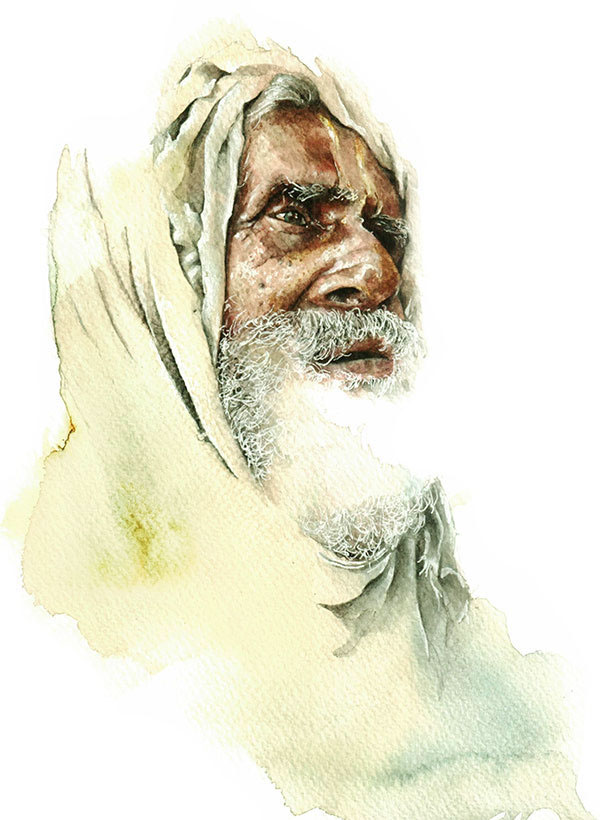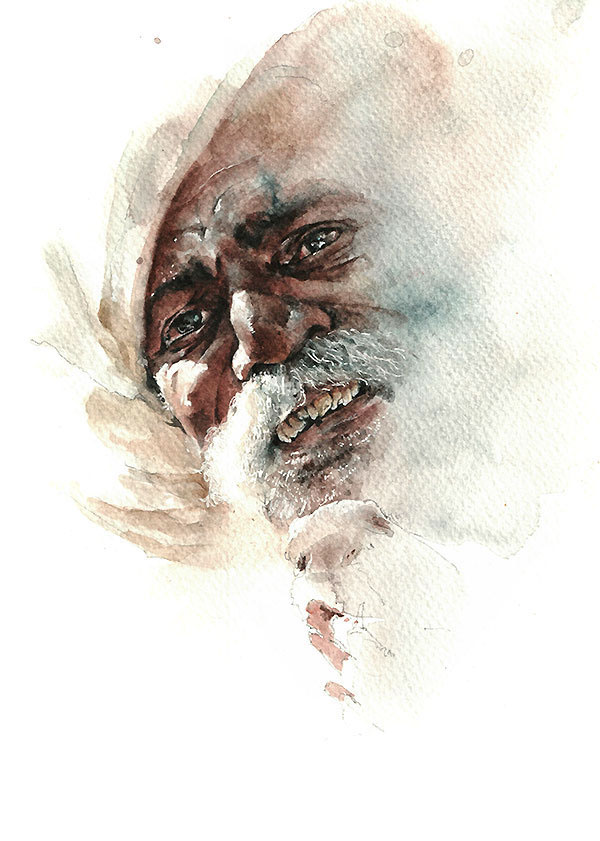MORE READINGS
READINGS / Looking Beyond: India through the eyes of Sunga Park, the travelling artist
Watercolours, oil and digital paintings are her tools. Architecture and people are her favourite subjects. Sunga Park is inseparable from her colouring kit when she travels around the world. She says, “I often found myself so stimulated that I couldn’t wait to sit down again with my paintbrush.” Despite having a signature style, her grasp on diversity is clear in the subtle distinctions in her work between different countries and also different places within each country. Through this article we explore her process and look at India through her eyes.
A bold brush stroke, watery yet heavily pigmented on an unbleached drawing paper, and I’m hooked. Stroke after stroke I find myself lost in the hues strictly obeying their master as she creates abstract patches of colour that will soon turn into a beautifully detailed painting. One can easily lose track of time and place while browsing through Sunga Park’s Behance portfolio.
From being Self-taught, to self-taught and thriving
Sunga is self-taught and that is evident in the freedom with which she creates her work. Originally from Busan, South Korea, she majored in economics but chose to follow her passion of painting for a career instead. Sunga’s foray into the creative world began with designing websites and then with drawings for children’s magazines; extending to graphic design and illustrations for other magazines as well. Today, her commercial projects include posters for events and brand creation for various companies apart from which she also sells her paintings online, both originals and prints.
She does commercial projects when she is based in her new home, Bangkok, and during her free time, she travels the world to feed her creativity. Breaking the monotony with travel helps her to bring something fresh to the table.
Why watercolour, over a lucrative digital career?
Most of her portfolio is made up of watercolours, which seems to be a particularly favoured medium. As one goes through her work, one spots some oils on canvas and some digital paintings as well. Having started with designing websites, she mentions her discomfort with the artificiality of the process and the fact that nobody can ‘save a moment’ or ‘undo what has been done’ in real life.
It was to explore this impermanence that she started using watercolours, a more hands-on way of learning. “Watercolours taught me about life because I made tonnes of failures over repeated attempts.” She mostly uses watercolours during her travels as they “dry fast and [are] easy to use for beginners and cheap too. These are a perfect fit for travelling.”
Painting on the go is often a balancing act between detailing and the ability to reduce things to their essence. Although her attention to detail is delightfully on point, she happily erases off details of paintings in order to convey her own authorship to a piece.
Decoding Sunga’s sketches, portraits and paintings.
Looking through Sunga's paintings is like having a conversation with the artist. They invariably take you on a journey and show you the places she visits, the locals she observes, the architecture and a tidbit on the context in which she painted.
Her subjects can be broadly categorised into portraits and architecture. Her portraits use more colour than her architectural sketches/paintings and the compositions are soaked in the colours she perceives, which she thinks best depict the intangible. The colour palette that is largely neutral in Europe, expands to every hue imaginable when she paints India.
For portraits, she sometimes takes photographs and completes the painting at a later time, but many times she just observes people and sketches them on the move. The main difference therefore between her paintings and sketches is that the latter are honest and belong to that moment.
Painting on the go is often a balancing act between detailing and the ability to reduce things to their essence. Although her attention to detail is delightfully on point, she happily erases off details of paintings in order to convey her own authorship to a piece.
Travelling in the vast abounds of India
Sunga visited India in 2014 and has travelled all over the country from Ladakh and Varanasi to Cochin and Tiruchirapalli. Since she sketches on site, she captures the moment as she perceives it. The beauty of her work is that it's momentary and fleeting; anyone, even a person new to India could use her paintings as a lens to look at its cultural, climatic and architectural diversity: the painstakingly-carved monoliths at Ellora; the grotesque detailing of the Gothic Chhatrapati Shivaji Terminus in Mumbai or the Chaturbhuj temple in Orchha.
Indian architecture can be extremely complex and detailed and it is overwhelming to visually grasp all of it at one glance. Its true beauty lies in acknowledging the fact that it is not humanly possible to absorb millennia of cultural layers in one viewing.
Her methodology is to slowly immerse herself in the culture of a place. In her words “My goal is always to bring out the character of a building or a street, and in order to do that, I need to first learn what that character is and how to interpret it visually.” She equates Indian architecture to a perfect blend of natural and man-made beauty. Such manifestations of beauty inspired her to sit for two whole days in the harsh Indian summer and work on a painting of the Kailash Temple at Ellora that kept drying too fast.
Indian architecture can be extremely complex and detailed and it is overwhelming to visually grasp all of it at one glance. Its true beauty lies in acknowledging the fact that it is not humanly possible to absorb millennia of cultural layers in one viewing.
Sunga’s maturity comes through in her sketches of India, as she doesn’t attempt to complete each and every detail of a building. Her response is more receptive and organic. She says, “During my time in India, I spent so much time exploring and learning that I grew as a traveller and as a person to a point where I consider myself much more independent now, and able to experiment more with my life and work.”


The first image represents Chhatrapati Shivaji Terminus, Mumbai that has had countless artistic depictions. As a major Gothic revival landmark of the city and being a “living heritage” building, this depiction by Sunga shows distortion due to its massive scale. The detailing has been restricted to a few iconic sculptures. The second frame contains the beautiful Chaturbhuj Temple at Orchha, Madhya Pradesh. It shows the extent of its detailed craftsmanship without indulging in every little detail.


The first image talks about a baba in Hampi. He was captured on paper with the summer sun beating harshly on his face. The drip effect of the painting seems to be relaying the hyperbolic effects of the heat while the second image represents a vegetable vendor in Bangalore. This process drawing shows how life was brought to an empirical sketch by Sunga Park and her watercolours.